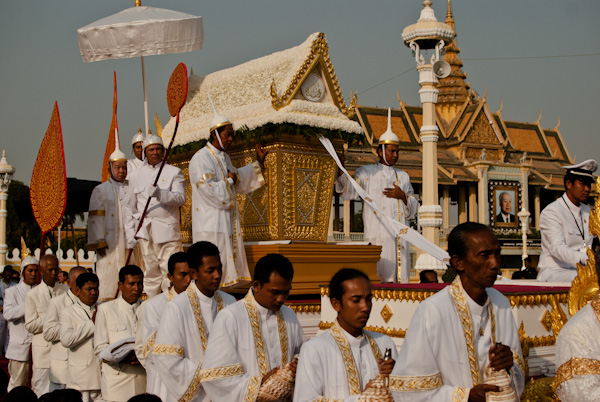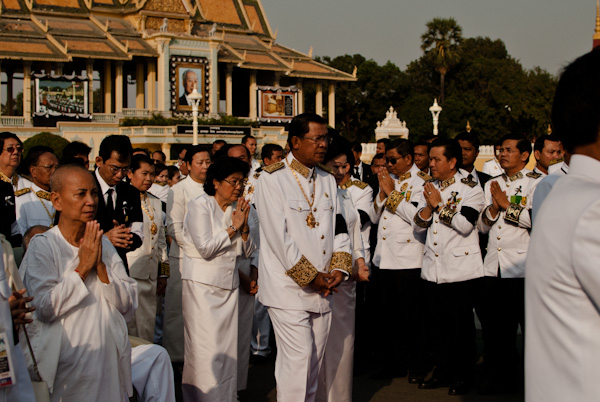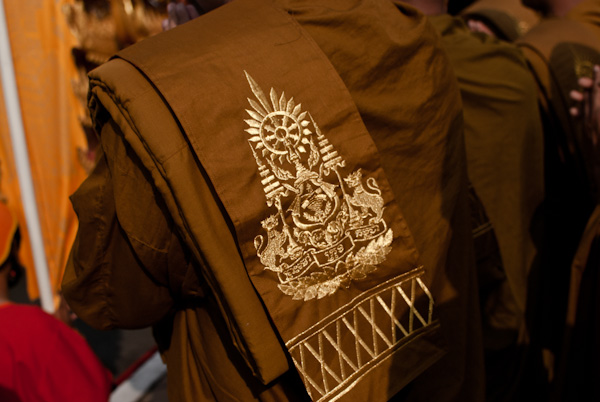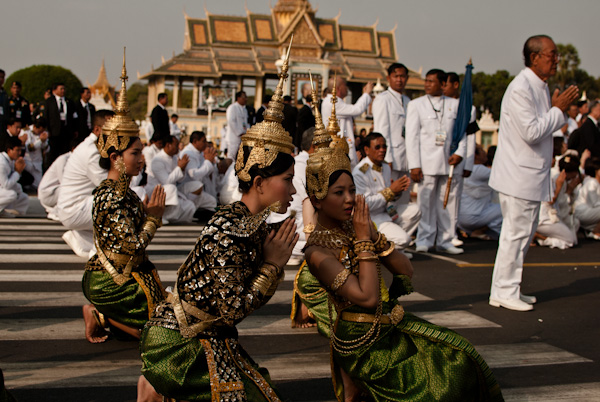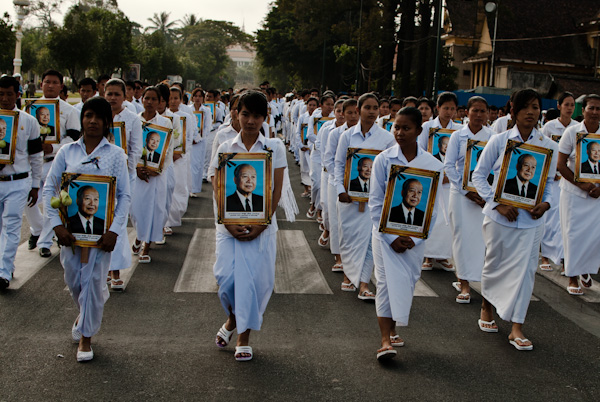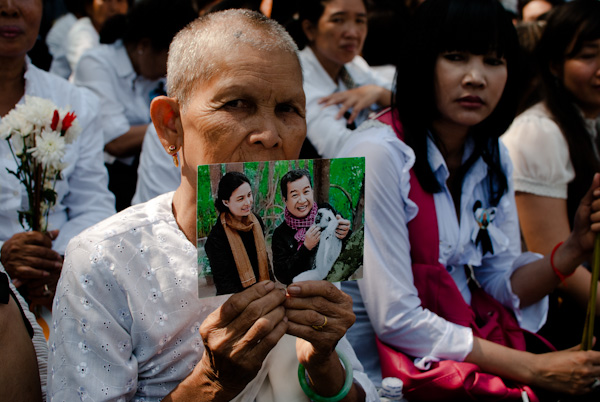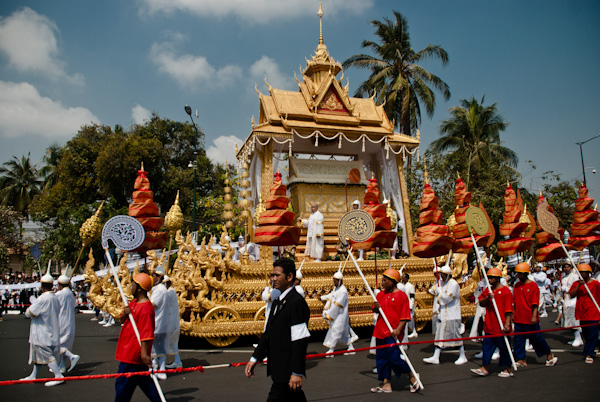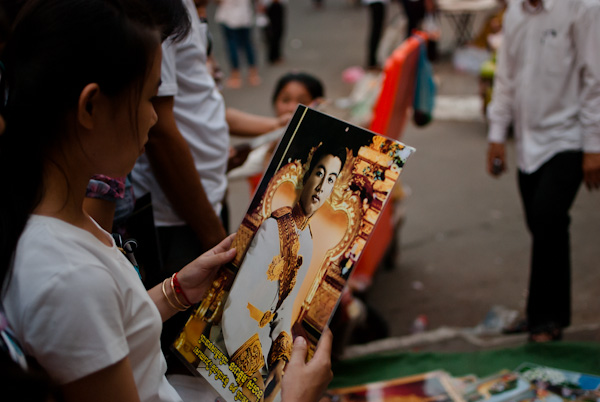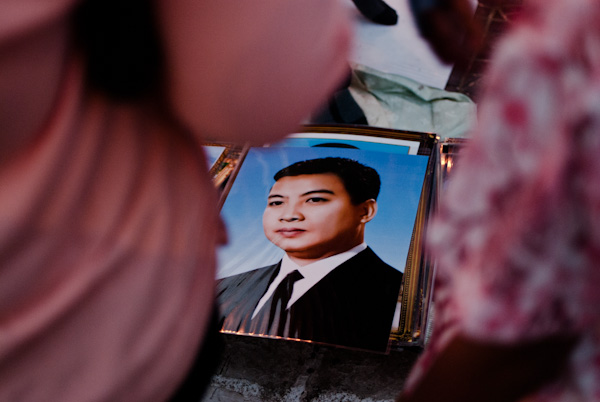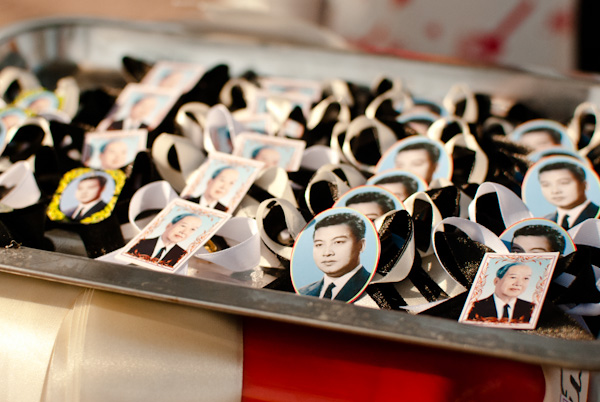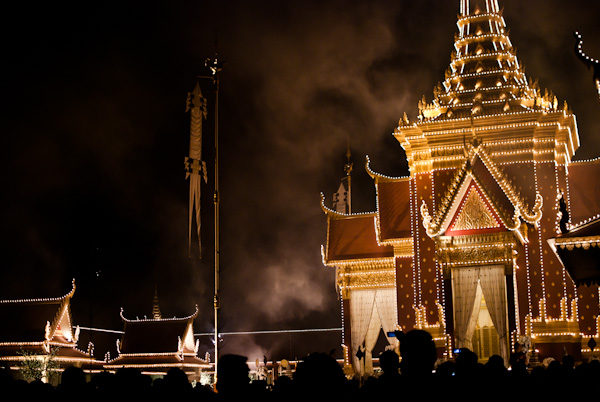PHNOM PENH – To the boom of artillery and the crackle of fireworks, Cambodians bid a final farewell this week to their beloved King Father Norodom Sihanouk. Across the country, citizens paused for a moment of silence as Sihanouk’s embalmed body was cremated in a lavish new structure built on hallowed ground next to the walls of the Royal Palace. Dozens of foreign dignitaries, including French Prime Minister Jean-Marc Ayrault and Prince Akishino of Japan, were on hand to witness the passing of Cambodia’s last God-King, who died in Beijing on October 15, two weeks shy of his 90th birthday.
As evening fell, the crematorium, a 47-meter-high tower topped with a golden spire, blazed with thousands of tiny lights as King Norodom Sihamoni and Queen Mother Monineath, both clad in white, entered its inner chamber. Half an hour later, Sihamoni symbolically lit his father’s sandalwood oil-soaked body and the former king was engulfed in flames, ascending in a cloud of smoke to the haunting strains of Cambodia’s traditional funeral music. The following day, some of Sihanouk’s ashes were scattered in the city’s churning river waters; the remainder of his ashes will be kept in a diamond-encrusted urn inside the Royal Palace.
So departed one of history’s great characters and iconoclasts, a reluctant monarch who came to personify his country’s violent and turbulent journey through the 20th century. Born in Phnom Penh on October 31, 1922, Sihanouk oversaw Cambodia’s transition from French colonialism to independence, and then its descent into the maelstrom of civil war and the brutal dictatorship of the communist Khmer Rouge. Along the way, he served in a bewildering array of roles, first as king, and subsequently as prime minister, head of state, non-aligned leader, communist figurehead, leader-in-exile, and finally as constitutional monarch until his abdication in 2004.
On Monday, tens of thousands of white-clad Cambodians gathered in a park a few blocks from the palace, where they awaited a chance to pay their final respects to their beloved Samdech Eav, or “Monsignor Papa”. “I think a lot about him,” said Saem Yeam, 77, who grew up under Sihanouk’s rule in the 1950s and 1960s. Clasping her hands together in a gesture of reverence, Yeam recalled the Sihanouk years as an island of peace before the turmoil of war and upheaval. “In that time, all of his children were very happy and educated. Everything was being developed. Everything was perfect,” she said.
So departed one of history’s great characters and iconoclasts, a reluctant monarch who came to personify his country’s violent and turbulent journey through the 20th century.
Despite the outpouring of nostalgia, Cambodia’s centuries-old monarchy faces an uncertain future. Since 2004, when Sihanouk abdicated in favor of his son Norodom Sihamoni, the monarchy has been elbowed aside by Prime Minister Hun Sen, the former communist who has run Cambodia with a firm hand for the past 28 years. In addition to being a moving send-off for the King Father, this week’s funeral ceremonies were also something of a victory lap for Hun Sen and his ruling Cambodian People’s Party (CPP) – the successful culmination of the party’s long effort to bind the monarchy in ceremony, shackle it with praise, and assert itself as the sole protector and heir of Sihanouk’s royal legacy.
Since 1979, when the CPP (then known as the Kampuchean People’s Revolutionary Party) was installed in power by Vietnam after it overthrew the Khmer Rouge regime, Sihanouk’s popularity has posed a persistent threat to its power. During the 1980s, when Sihanouk was part of a resistance coalition fighting the regime in Phnom Penh, the CPP-run press denounced the ex-king as an “exploitative” feudal reactionary opposed to the interests of the working class. The CPP’s attitude started to shift as peace talks advanced in the late 1980s: when Sihanouk returned to Cambodia from exile in November 1991, shortly after the signing of the Paris Peace Accords, Hun Sen rode with him into town past ecstatic crowds. In 1992, the CPP party mouthpiece Pracheachon praised Sihanouk and described the CPP as the “little brother” of Sihanouk’s earlier regime.
Gilded cage
At the same time, however, the CPP also sought to restrict the returning monarch’s ambitions. After he was re-crowned king in September 1993, it went to great lengths to confine Sihanouk to the roles laid down in the new constitution, which specified that the king reign but not rule. “From the beginning, the CPP saw the danger of giving the monarchy a free reign, because of the popularity of the King Father with the rural population,” said Julio Jeldres, Sihanouk’s official biographer. “So from the beginning, everything was tightly controlled.”
A few days before the September 24 coronation of King Sihanouk, Kong Samol, an American-educated agronomist and current CPP Politburo member, was appointed minister of the Royal Palace, a position he has held ever since. Sources close to the palace say the minister has kept King Sihamoni under increasingly close surveillance, preventing him from meeting the people or traveling freely around the country.
Sihanouk initially bucked against these restrictions, hoping to maneuver himself back into the political game. After several failed attempts to form his own government after the UN-backed 1993 elections, Sihanouk found himself increasingly bereft of power. His son, Prince Norodom Ranariddh, won the election and ruled in coalition with Hun Sen, but increasingly bucked and ignored his father’s wishes. In July 1997, Hun Sen overthrew Ranariddh in a bloody coup de force, an event that marked a further diminution of Sihanouk’s power.
Henceforth, the king spent an increasing amount of time outside the country, particularly in Beijing, where he penned sorrowful and acerbic commentaries lamenting the corruption and injustice of Hun Sen’s rule. Hun Sen, at the same time, donned Sihanouk’s mantle, replicating his hours-long speeches, school construction drives, and close identification with Cambodia’s “little people”. “Hun Sen has always wanted to become the Sihanouk of his era, and somehow he has succeeded,” said Prince Sisowath Thomico, one of Sihanouk’s former aides.
Realizing that the game was up, Sihanouk finally stepped down in 2004, ceding the throne to his son Sihamoni and the political arena to Hun Sen, who he increasingly took to describing as the “son” he never had. “Sihanouk had one big ambition that remained unfulfilled and that was to rule over a prosperous and peaceful Cambodia,” said Benny Widyono, author of Dancing in Shadows: Sihanouk, the Khmer Rouge, and the United Nations in Cambodia. “He had realized he couldn’t beat Hun Sen. His lifelong ambition remained unfulfilled.”
King Sihamoni, a former ballet dancer who spent years as Cambodia’s ambassador to UNESCO in Paris, has shown little taste for the political game, leaving politics to Hun Sen and his CPP dominated government. In the end, with Hun Sen consolidating his own power and marginalizing royalist rivals like Ranariddh, Sihanouk chose to abdicate in a bid to ensure the monarchy would survive beyond his own death.
“He had to make sure the monarchy would survive. His only choice was to abdicate and have the council of the throne to elect a new king,” said Thomico. But if the ascension of Sihamoni saved the monarchy from Hun Sen’s attacks, it also gave the CPP what they had wanted all along: a king who would stay out of politics. “If I was to write a book about Sihamoni I would call it The Reluctant King,” said Widyono. “He fits Hun Sen’s bill very well.”
As a result, Sihanouk’s passing has been politically muted – a final lavish seal on the monarchy’s withdrawal from political life. And the CPP has spared no expense in asserting itself as the sole guardian of his legacy. The government reportedly spent US$5 million building the soaring crematorium that was the centerpiece of the weekend’s tightly-scripted ceremonies. On Friday, a lavish funeral procession bore Sihanouk’s casket through the streets of Phnom Penh for one last time, while loudspeakers rigged across town broadcast eulogies of the King Father and long lists of his achievements.
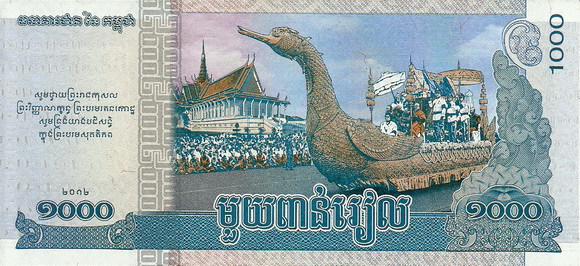
The new 1,000-riel note bearing an image of Norodom Sihanouk’s funeral cortège.
In addition, the government minted a new title for the departed King Father, who will henceforth be known by the honorific Preah Borom Ratanak Koad, as well as a new 1,000 riel (US$0.24) note bearing an image of the golden funeral carriage which bore his body home from Beijing in October. (The only country in the world to boast a ruin on its national flag, Cambodia is now likely the first to have a funeral on its currency). Then came Monday’s beautiful cremation, a final flourish of tradition that drew a firm line between the fading era of Sihanouk and the rising era of Hun Sen.
“Hun Sen says, give them the last rites,” said one former Asian diplomat. “After that, the monarchy will be lost in oblivion.”
Phay Siphan, a government spokesman, said that under the Constitution, the king had no political power but still retained a “power of conscience”. Government officials meet regularly with King Sihamoni to discuss the state of the country, he said, but denied the government kept the palace on a short leash. “It’s groundless. Why would we monitor it?” Siphan said. “We have no power to decide for the king.”
For now, many Cambodians remain fixated on the past, mourning Sihanouk’s life and achievements. Since Friday, Mao Sovann, 54, has sold hundreds of commemorative photographs of the King Father. Spread out in front of her in the park, they show Sihanouk as a young man, haughty in the early years of his reign, and Sihanouk in suit and tie, at the cherubic peak of his power in the mid-1960s. Other portraits show Sihanouk and his wife in the black pajamas of the Khmer Rouge in 1973, and later in a formal portrait alongside their son Sihamoni.
“Everybody loves him and wants to keep photos for their children and grandchildren,” Sovann said. “The next generation who didn’t know him, we will show them the pictures.” And as for the future? “I don’t know what’s going on,” she said. “Right now there’s only one thing I know: Prime Minister Hun Sen – he’s in charge of everything.”
[Published by Asia Times Online, February 6, 2013]


